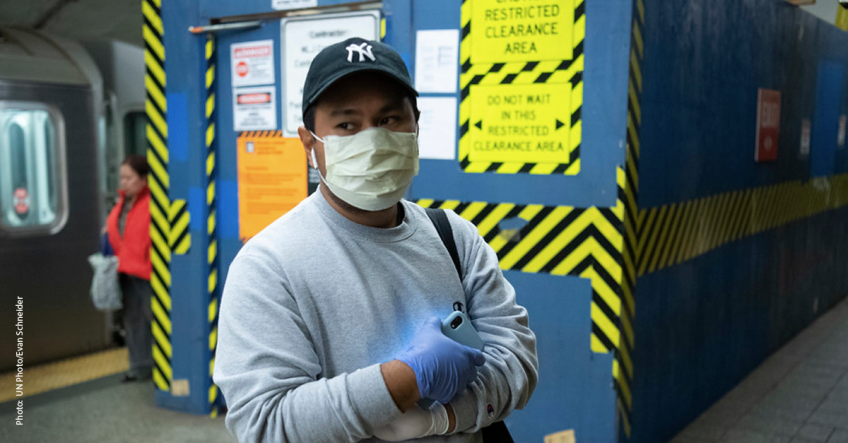
World Economic Situation And Prospects: April 2020 Briefing, No. 136
COVID-19: Disrupting lives, economies and societies
A raging pandemic—unleashed by a highly contagious COVID-19 virus—has triggered unprecedented restrictions not only on the movement of people but also on a range of economic activities, and the declaration of national emergencies in most countries in Europe and North America. Growing demand for urgent healthcare and rising death tolls are straining national healthcare systems. The pandemic is disrupting global supply chains and international trade. With nearly 100 countries closing national borders during the past month, the movement of people and tourism flows have come to a screeching halt. Millions of workers in these countries are facing the bleak prospect of losing their jobs.
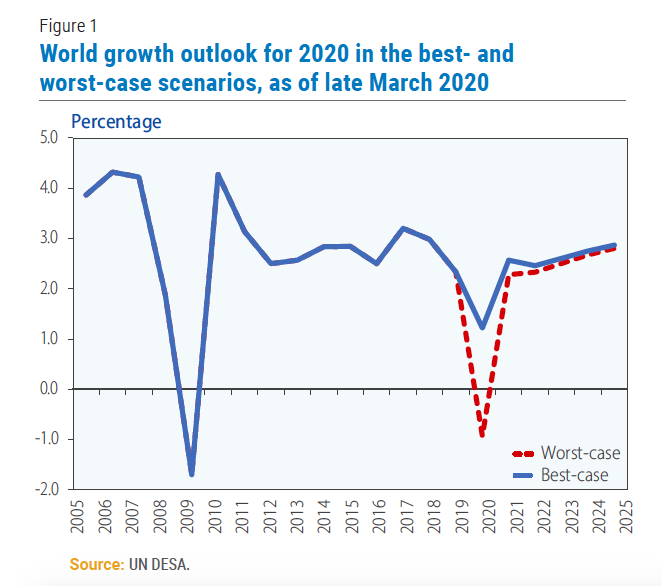 Governments are considering and rolling out large stimulus packages to avert a sharp downturn of their economies which could potentially plunge the global economy into a deep recession. In the worst-case scenario, the world economy could contract by 0.9 per cent in 2020 (Figure 1). “Urgent and bold policy measures are needed, not only to contain the pandemic and save lives, but also to protect the most vulnerable in our societies from economic ruin and to sustain economic growth and financial stability,” stressed Under-Secretary-General for Economic and Social Affairs Liu Zhenmin.
Governments are considering and rolling out large stimulus packages to avert a sharp downturn of their economies which could potentially plunge the global economy into a deep recession. In the worst-case scenario, the world economy could contract by 0.9 per cent in 2020 (Figure 1). “Urgent and bold policy measures are needed, not only to contain the pandemic and save lives, but also to protect the most vulnerable in our societies from economic ruin and to sustain economic growth and financial stability,” stressed Under-Secretary-General for Economic and Social Affairs Liu Zhenmin.
Economic Consequences
Fears of the exponential spread of the virus—and growing uncertainties about the efficacy of various containment measures—have rocked financial markets worldwide, with market volatility surpassing its peak during the global financial crisis (Figure 2) and equity markets and oil prices plunging to multi-year lows.
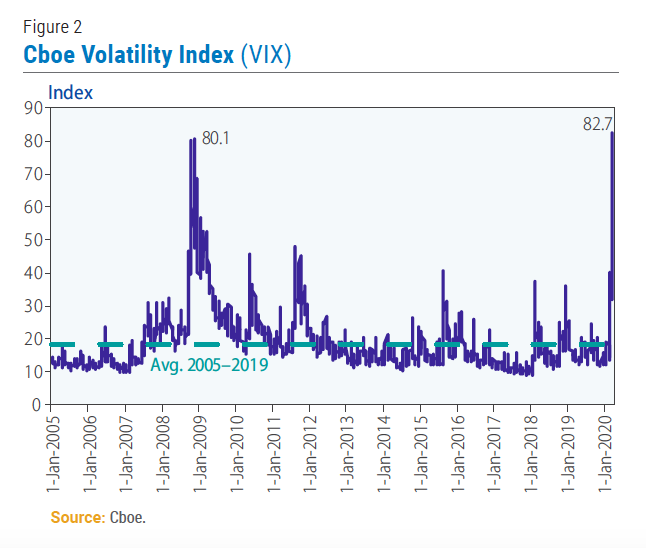 Large declines in asset prices and high financial market volatility will impact real economic activities via credit and investment channels. Lower equity prices will increase the debt-to-equity ratios of highly leveraged firms, limiting their access to credit and increasing the likelihood of default and bankruptcies. The tightening of credit conditions could force firms to deleverage rapidly, exacerbating a downturn. Banks may be forced to reduce lending, adding to downward pressures in the credit market. As corporate and consumer loan defaults rise, this would also result in a deterioration in bank balance sheets, further constraining banks’ ability to extend credit, and increasing the fragility of domestic banking systems.
Large declines in asset prices and high financial market volatility will impact real economic activities via credit and investment channels. Lower equity prices will increase the debt-to-equity ratios of highly leveraged firms, limiting their access to credit and increasing the likelihood of default and bankruptcies. The tightening of credit conditions could force firms to deleverage rapidly, exacerbating a downturn. Banks may be forced to reduce lending, adding to downward pressures in the credit market. As corporate and consumer loan defaults rise, this would also result in a deterioration in bank balance sheets, further constraining banks’ ability to extend credit, and increasing the fragility of domestic banking systems.
Growing restrictions on the movement of people and lockdowns in Europe and North America are hitting the service sector hard, particularly industries that involve physical interactions such as retail trade, leisure and hospitality, recreation and transportation services. Collectively, they account for more than a quarter of all jobs in these economies. As businesses lose revenue, unemployment is likely to increase sharply, transforming a supply-side shock to a wider demand-side shock for the economy.
The adverse effects of prolonged restrictions on economic activities in developed economies will soon spill over to developing countries via trade and investment channels. A sharp decline in consumer spending in the European Union (EU) and the United States will reduce imports of consumer goods from developing countries. In addition, global manufacturing production could contract significantly, amid the possibility of extended disruptions to global supply chains. In recent weeks, several automobile companies have announced large-scale production suspensions in Europe and the United States. Many firms worldwide—particularly in the automobile, consumer electronics, and telecommunications industries—are facing shortages of intermediate components as exports from China contracted at an annual pace of 17.2 per cent in the first two months of the year. More severe and protracted production disruptions would affect a large number of developing economies that are deeply integrated in global supply networks.
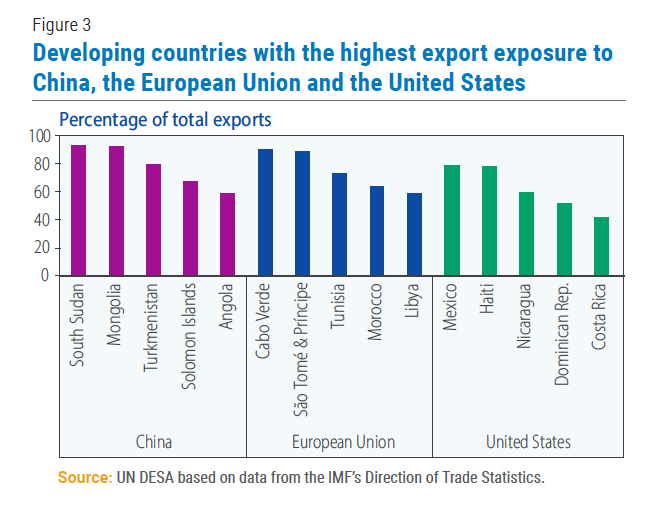 Developing countries with highly concentrated trade exposures to the EU and the United States are particularly vulnerable to growth downturns in these two economies (Figure 3). For example, nearly 90 per cent of exports from Cabo Verde and São Tomé and Príncipe are destined for Europe. For Morocco and Tunisia, it is over 60 per cent. If demand from the EU falls, these economies will suffer significant downturns. The same is true for the Dominican Republic, Haiti or Mexico, with more than half of their exports destined to one country—the United States.
Developing countries with highly concentrated trade exposures to the EU and the United States are particularly vulnerable to growth downturns in these two economies (Figure 3). For example, nearly 90 per cent of exports from Cabo Verde and São Tomé and Príncipe are destined for Europe. For Morocco and Tunisia, it is over 60 per cent. If demand from the EU falls, these economies will suffer significant downturns. The same is true for the Dominican Republic, Haiti or Mexico, with more than half of their exports destined to one country—the United States.
The pandemic is also hitting the global tourism industry just as hard. As a growing number of countries close their borders, travels—both domestic and international—have come to a standstill. In February, China’s air passenger traffic fell by 84.5 per cent on a year-on-year basis, while Sri Lanka and Viet Nam saw tourist arrivals contract by double-digits relative to February last year. More prolonged restrictions on international travel could severely hurt developing economies that are highly reliant on tourism as a source of foreign exchange revenue (Figure 4). In the Bahamas, Cabo Verde, Maldives and Vanuatu, tourism accounts for nearly 20 per cent of GDP and nearly 60 per cent of their foreign exchange earnings. Small- and medium-sized enterprises (SMEs) account for 80 per cent of the global tourism sector which employs approximately 123 million people worldwide. Many tourism-dependent countries rely heavily on tourist arrivals from a particular country—the United States, for example—as in the case of many Caribbean economies. These economies would experience sharp increases in unemployment rates, affecting the livelihood of low-skilled workers and the more vulnerable segments of society that depend on income from tourism-related industries.
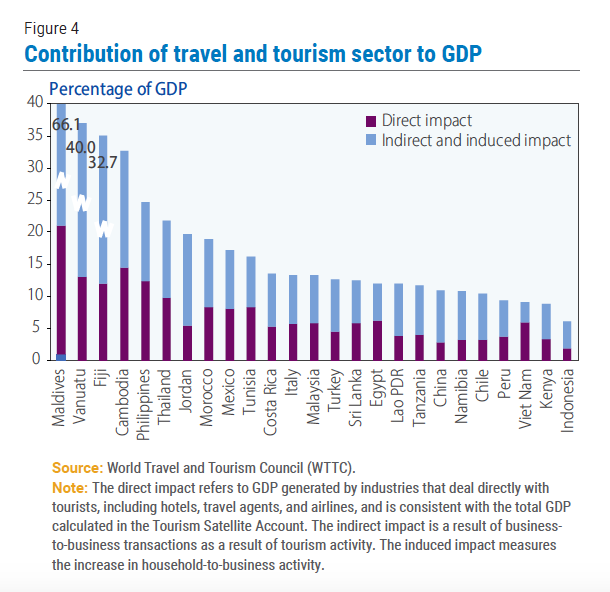 The recent collapse in global commodity prices is com– pounding the bleak fiscal outlook for many commodity-exporting economies, many of which have not fully recovered from the after-effects of the sharp commodity price decline in 2014–2016. As world demand weakens amid widening travel restrictions, oil prices have fallen to the lowest level in nearly two decades. Production disagreements between the Russian Federation and Saudi Arabia are adding to high uncertainty in the global oil market. For many non-oil commodity-dependent economies, the decline in commodity-related revenues and a reversal of capital flows are increasing the likelihood of debt distress. Particularly at risk are commodity exporters with high levels of external debt. Mongolia, a commodity-dependent economy with 90 per cent of its exports going to China, has an external debt-to-GDP ratio of over 220 per cent of its GDP. The Republic of Congo, Mauritania and Mozambique—all commodity dependent economies—have similarly high levels of external debt. Growing debt distress—and likelihood of a debt crisis—could force many governments to sharply curtail public expenditure at a time when they need to ramp up spending to contain the pandemic and support consumption and investment.
The recent collapse in global commodity prices is com– pounding the bleak fiscal outlook for many commodity-exporting economies, many of which have not fully recovered from the after-effects of the sharp commodity price decline in 2014–2016. As world demand weakens amid widening travel restrictions, oil prices have fallen to the lowest level in nearly two decades. Production disagreements between the Russian Federation and Saudi Arabia are adding to high uncertainty in the global oil market. For many non-oil commodity-dependent economies, the decline in commodity-related revenues and a reversal of capital flows are increasing the likelihood of debt distress. Particularly at risk are commodity exporters with high levels of external debt. Mongolia, a commodity-dependent economy with 90 per cent of its exports going to China, has an external debt-to-GDP ratio of over 220 per cent of its GDP. The Republic of Congo, Mauritania and Mozambique—all commodity dependent economies—have similarly high levels of external debt. Growing debt distress—and likelihood of a debt crisis—could force many governments to sharply curtail public expenditure at a time when they need to ramp up spending to contain the pandemic and support consumption and investment.
Scenario Analysis
Before the outbreak of COVID-19, world output was expected to expand at a modest pace of 2.5 per cent in 2020, as reported in the World Economic Situation and Prospects 2020. Taking into account rapidly changing economic conditions, UN DESA’s World Economic Forecasting Model has estimated best- and worst-case scenarios for global growth in 2020.
"Urgent and bold policy measures are needed, not only to contain the pandemic and save lives, but also to protect the most vulnerable in our societies from economic ruin and to sustain economic growth and financial stability.”
In the best-case scenario—with moderate declines in private consumption, investment and exports and offsetting increases in government spending in the G-7 countries and China—global growth would fall to 1.2 per cent in 2020.
In the worst-case scenario, the global output would contract by 0.9 per cent—instead of growing by 2.5 per cent—in 2020.The scenario is based on demand-side shocks of different magnitudes to China, Japan, the Republic of Korea, the United States and the EU, as well as an oil price decline of 50 per cent against our baseline of US$ 61 per barrel. It assumes that wide-ranging restrictions on economic activities in the EU and the United States would extend until the middle of the second quarter. Global growth could plunge even further if restrictions on movements and economic activities in these economies would extend beyond the second quarter. The world economy contracted by 1.7 per cent during the global financial crisis in 2009.
The severity of the economic impact will largely depend on two factors: (1) the duration of restrictions on the movement of people and economic activities in major economies; and (2) the actual size and efficacy of fiscal responses to the crisis. A well-designed fiscal stimulus package, prioritizing health spending to contain the spread of the virus and providing income support to households most affected by the pandemic would help to minimize the likelihood of a deep economic recession.
Development Implications
The COVID-19 pandemic will not only suppress economic growth, it will also adversely impact sustainable development in the short run. In Africa, an outbreak of the virus is of extreme concern because of the fragility of countries’ healthcare systems and because many of these economies already face significant public health challenges, particularly malaria, measles, HIV, and tuberculosis. During the 2014–16 Ebola outbreak, many of the deaths were due to resources being diverted away from other diseases. In Western Asia, the pandemic is likely to impact humanitarian action of the international community in Iraq, Syria and Yemen, where ongoing conflict still requires timely responses.
The pandemic is also likely to undermine poverty eradication efforts. A pandemic-stricken economy that grinds to a halt puts the employment of many people at risk—either in the form of lower income, less paid working hours, or outright unemployment. Without prompt government support, households could quickly fall into poverty, reversing past gains.
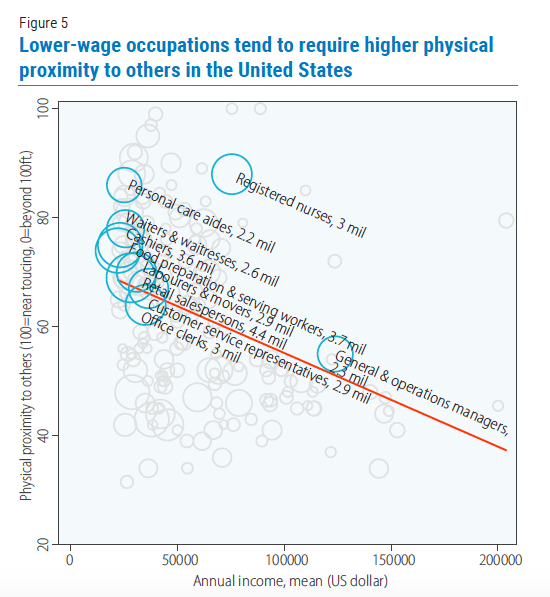 The pandemic will have differentiated employment and income effects, even in most developed economies. Evidence suggests that those at the lower end of the income distribution will suffer the most. Lower-income workers tend to enjoy less labour market protection —a considerable share of them work in informal sectors where protection is minimal; and even for those in the formal sectors, many are paid by the hour, with typically little or no paid sick leave. Furthermore, a high share of lower-income workers is employed in industries that are most affected by the pandemic, such as retail sales and food service industries, which require close physical proximity to others. In the case of the United States, over a quarter of jobs require workers to work at arm’s length of others, and a vast majority of them are lower-wage jobs (see Figure 5). The unfortunate combination of subpar labour market protection and close physical proximity to others means lower-wage workers are disproportionately harmed by the pandemic, in terms of both economic and health outcomes. The vicious cycle between low socio-economic status and high health risk could exacerbate the high levels of income inequality in many countries.
The pandemic will have differentiated employment and income effects, even in most developed economies. Evidence suggests that those at the lower end of the income distribution will suffer the most. Lower-income workers tend to enjoy less labour market protection —a considerable share of them work in informal sectors where protection is minimal; and even for those in the formal sectors, many are paid by the hour, with typically little or no paid sick leave. Furthermore, a high share of lower-income workers is employed in industries that are most affected by the pandemic, such as retail sales and food service industries, which require close physical proximity to others. In the case of the United States, over a quarter of jobs require workers to work at arm’s length of others, and a vast majority of them are lower-wage jobs (see Figure 5). The unfortunate combination of subpar labour market protection and close physical proximity to others means lower-wage workers are disproportionately harmed by the pandemic, in terms of both economic and health outcomes. The vicious cycle between low socio-economic status and high health risk could exacerbate the high levels of income inequality in many countries.
The pandemic also throws a spotlight on other dimensions of inequality. There could be a gendered impact as women typically comprise the majority of health and social care workers who are more exposed to infection. Closing schools also makes the digital divide more pronounced. Students who are on the wrong side of the divide are not able to take full advantage of remote learning. The digital divide could translate into an educational divide, with possible long-term consequences.
With its detrimental effect on people’s wellbeing, the COVID-19 pandemic worsens the deep-seated economic anxiety— fuelled by slower growth and higher inequality—that people around the world are experiencing. Even in many high-income countries, a significant proportion of the population do not have enough financial wealth to live beyond the national poverty line for three months, causing many to fear for their economic security. In hard-hit Italy and Spain, an estimated 27 per cent and 40 per cent of the population, respectively, do not have enough savings to allow themselves not to work for more than three months, even if they are only living at the poverty line; and the number is an alarming 39 per cent for the OECD average. In the United States, nearly 40 per cent of households cannot pay for a $400 unexpected expense without borrowing or selling off some of their assets. Prolonged restrictions on economic activities—and the risk of losing jobs and income—would exacerbate pervasive economic insecurity and further erode the already-declining public trust in institutions, including multilateral organizations. Low public trust could undermine governments’ efforts to quickly contain the virus, heightening the sense of economic insecurity among a large segment of the population.
Macroeconomic And Development Policies
In response to the escalating health emergency and rapidly deteriorating economic outlook, national authorities and multilateral entities worldwide are considering unprecedented policy measures. Central banks across developed and developing countries have moved aggressively to help stave off the crisis, slashing interest rates, injecting liquidity and providing emergency funding for firms and households. Since the outbreak of the crisis, about 60 different monetary authorities have cut their policy rates, often at emergency meetings. The US Federal Reserve Bank (Fed) lowered its target rate by 150 basis points to 0.0–0.25 per cent, while the Bank of England cut its rate by 50 basis points to 0.25 per cent. Emerging market central banks, especially in East Asia, Western Asia and Latin America, also implemented rate cuts. In addition, major central banks boosted liquidity in the financial systems and restarted (Fed) or expanded (European Central Bank, Bank of Japan) their asset purchase programs.
While interest rate cuts and asset purchases can send important market signals, they will do little to stimulate economic activity in the short run. Central bank actions, however, still ease financial stress, ensure a continued functioning of financial markets, and provide loans for businesses and households affected by the crisis. Once the social restrictions are lifted and market confidence returns, a prolonged period of very low interest rates could help support economic recovery. Importantly, medium-term monetary policy strategies will need to be aligned with new fiscal realities, including large deficits and higher debt levels.
Given the severity of the crisis and the limited effectiveness of monetary policy actions, many governments, especially in East Asia and in developed countries, have announced large stimulus packages to address the health, economic and social impacts of the pandemic. They are primarily targeted at enhancing capacities of national health sectors to ensure the availability of medical supplies, free and aggressive COVID-19 testing and enhanced healthcare coverage, and funding for research and development of vaccines and treatments. At the same time, fiscal policy measures are aiming to expand paid sick leave and family leave, mitigating income losses with direct and indirect cash-transfers and preventing business closures and bankruptcies. In the United States, only 74 per cent of all workers have paid sick leave and only 45 per cent have paid personal/family leave.
Direct wage or income support measures can play an important role in limiting the socio-economic effects in the short run, while preserving the capacity to recover promptly. Such measures include tax deferrals, government-subsidized short-term work schemes, moratoriums on mortgage payments and direct cash payments. Importantly, social protection programmes need to reach the most in need during the crisis, with a focus on the elderly and those in vulnerable employment.
During the global financial crisis, a one-time stimulus payment, for example, was apparently more effective than payroll tax cuts at boosting consumption in the United States. Also, the latter approach would not help those who are in the informal sector or do not earn enough to pay tax. A bolder approach, as proposed by Saez and Zucman, is for government to act as a “payer of last resort”, channelling special unemployment insurance benefits to idle workers, even though they stay employed, and payments to businesses for covering necessary maintenance cost.
Strengthened international cooperation—complementing and strengthening national efforts—remains an imperative for fighting the pandemic. As the coronavirus knows no border, the global health system is only as strong as its weakest link. In this view, the collective interest of the global community is best served if information on good practices on fighting the pandemic are shared widely, intellectual property regimes that govern the use of vaccines are made flexible, and financial support for the World Health Organization is strengthened. Many multilateral entities, including the IMF and World Bank have already made significant resources available to support countries that face significant resource constraints and challenges in dealing with the fallout of the pandemic.
- Press Release: COVID-19 likely to shrink global GDP by almost one per cent in 2020
- 新闻稿: COVID-19 可能导致 2020 年全球 GDP 下降近 1%
- Comunicado de Prensa: Es probable que la COVID-19 reduzca el PIB global del 2020 en casi un 1 %

Follow Us